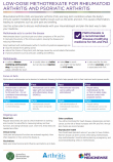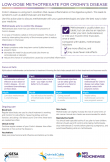Make sure you take the right dose
Methotrexate tablets come in 2 strengths: 2.5 mg and 10 mg. When you collect your methotrexate prescription, check that your tablets are the right strength, and that you have the right number of tablets. If your tablets look different to your last supply, get advice from your doctor or pharmacist.
Blood tests
While you are taking methotrexate you will need to have regular blood tests. These check the treatment is working and monitor for side effects, measure kidney and liver function, and do a full blood count. Over time, these tests are needed less often.
Vaccines
It is safe for you to have the annual flu vaccine. Keep your flu vaccinations up to date to reduce your risk of getting the flu. Some vaccines should not be taken if you are taking methotrexate. Always check with your doctor or pharmacist first.
Sun protection
Methotrexate makes your skin more sensitive to the sun. Protect your skin when you are in the sun, especially between 10am and 3pm. If outdoors, wear protective clothing and use a high factor sunscreen (SPF 30+).
Pregnant or planning a pregnancy
Methotrexate should not be taken if you are pregnant. If either you or your partner are taking methotrexate, talk to your doctor about contraception. If you or your partner wish to become pregnant, ask your doctor about stopping methotrexate. It should not be taken for at least 3 months before pregnancy.
Tell your healthcare providers
Make sure you tell anyone providing you with health, dental or medical care that you are taking methotrexate.









